Professional Accountability in Nursing: A Case Study Analysis
VerifiedAdded on 2023/01/16
|11
|2672
|83
AI Summary
This essay critically analyzes a case of professional misconduct in nursing, discussing the actions and system-based factors contributing to the adverse outcome for the patient. It also suggests strategies to prevent such errors in the future.
Contribute Materials
Your contribution can guide someone’s learning journey. Share your
documents today.

Running head: PROFESSIONAL ACCOUNTABILITY
Professional accountability
Name of the student:
Name of the University:
Author’s note
Professional accountability
Name of the student:
Name of the University:
Author’s note
Secure Best Marks with AI Grader
Need help grading? Try our AI Grader for instant feedback on your assignments.
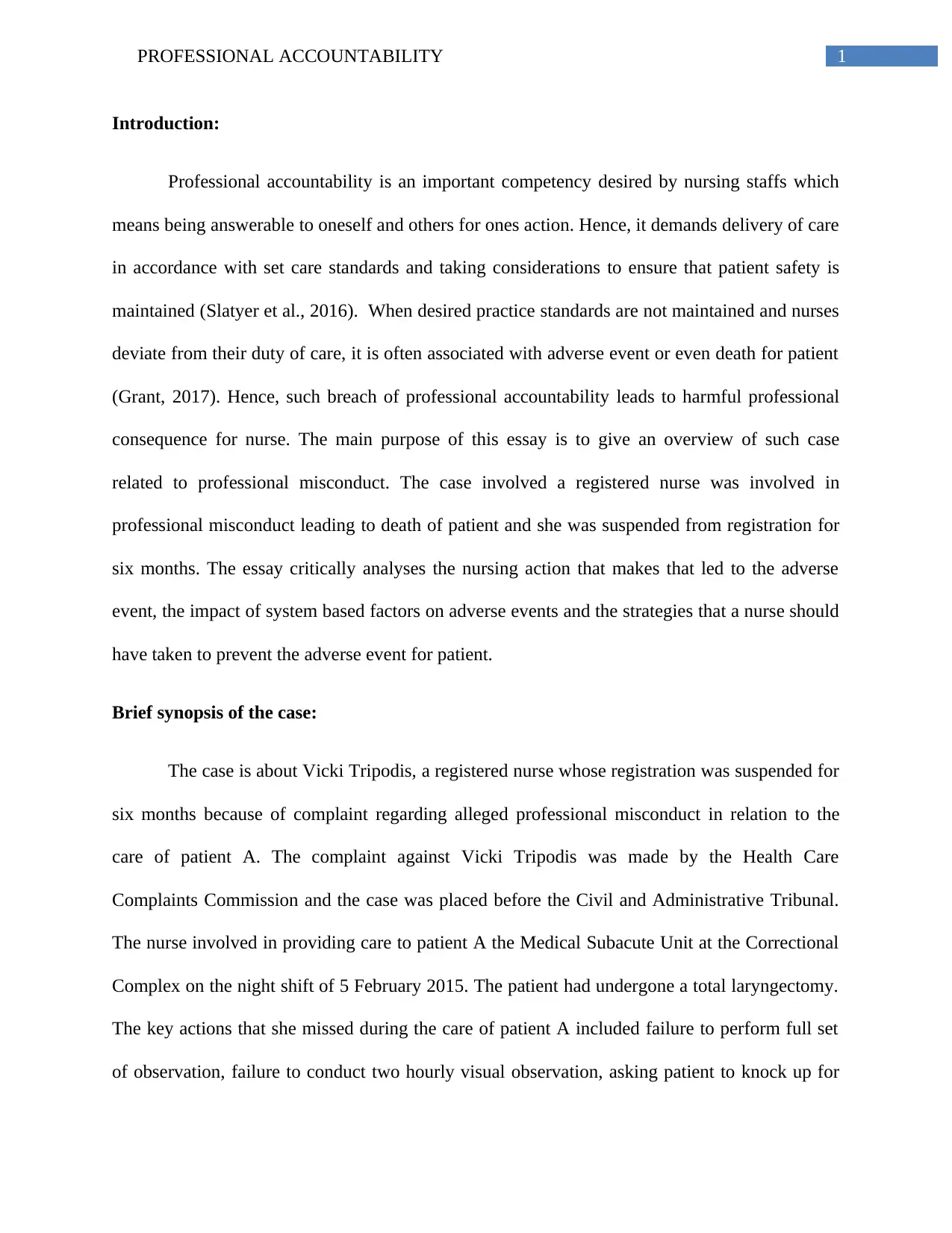
1PROFESSIONAL ACCOUNTABILITY
Introduction:
Professional accountability is an important competency desired by nursing staffs which
means being answerable to oneself and others for ones action. Hence, it demands delivery of care
in accordance with set care standards and taking considerations to ensure that patient safety is
maintained (Slatyer et al., 2016). When desired practice standards are not maintained and nurses
deviate from their duty of care, it is often associated with adverse event or even death for patient
(Grant, 2017). Hence, such breach of professional accountability leads to harmful professional
consequence for nurse. The main purpose of this essay is to give an overview of such case
related to professional misconduct. The case involved a registered nurse was involved in
professional misconduct leading to death of patient and she was suspended from registration for
six months. The essay critically analyses the nursing action that makes that led to the adverse
event, the impact of system based factors on adverse events and the strategies that a nurse should
have taken to prevent the adverse event for patient.
Brief synopsis of the case:
The case is about Vicki Tripodis, a registered nurse whose registration was suspended for
six months because of complaint regarding alleged professional misconduct in relation to the
care of patient A. The complaint against Vicki Tripodis was made by the Health Care
Complaints Commission and the case was placed before the Civil and Administrative Tribunal.
The nurse involved in providing care to patient A the Medical Subacute Unit at the Correctional
Complex on the night shift of 5 February 2015. The patient had undergone a total laryngectomy.
The key actions that she missed during the care of patient A included failure to perform full set
of observation, failure to conduct two hourly visual observation, asking patient to knock up for
Introduction:
Professional accountability is an important competency desired by nursing staffs which
means being answerable to oneself and others for ones action. Hence, it demands delivery of care
in accordance with set care standards and taking considerations to ensure that patient safety is
maintained (Slatyer et al., 2016). When desired practice standards are not maintained and nurses
deviate from their duty of care, it is often associated with adverse event or even death for patient
(Grant, 2017). Hence, such breach of professional accountability leads to harmful professional
consequence for nurse. The main purpose of this essay is to give an overview of such case
related to professional misconduct. The case involved a registered nurse was involved in
professional misconduct leading to death of patient and she was suspended from registration for
six months. The essay critically analyses the nursing action that makes that led to the adverse
event, the impact of system based factors on adverse events and the strategies that a nurse should
have taken to prevent the adverse event for patient.
Brief synopsis of the case:
The case is about Vicki Tripodis, a registered nurse whose registration was suspended for
six months because of complaint regarding alleged professional misconduct in relation to the
care of patient A. The complaint against Vicki Tripodis was made by the Health Care
Complaints Commission and the case was placed before the Civil and Administrative Tribunal.
The nurse involved in providing care to patient A the Medical Subacute Unit at the Correctional
Complex on the night shift of 5 February 2015. The patient had undergone a total laryngectomy.
The key actions that she missed during the care of patient A included failure to perform full set
of observation, failure to conduct two hourly visual observation, asking patient to knock up for
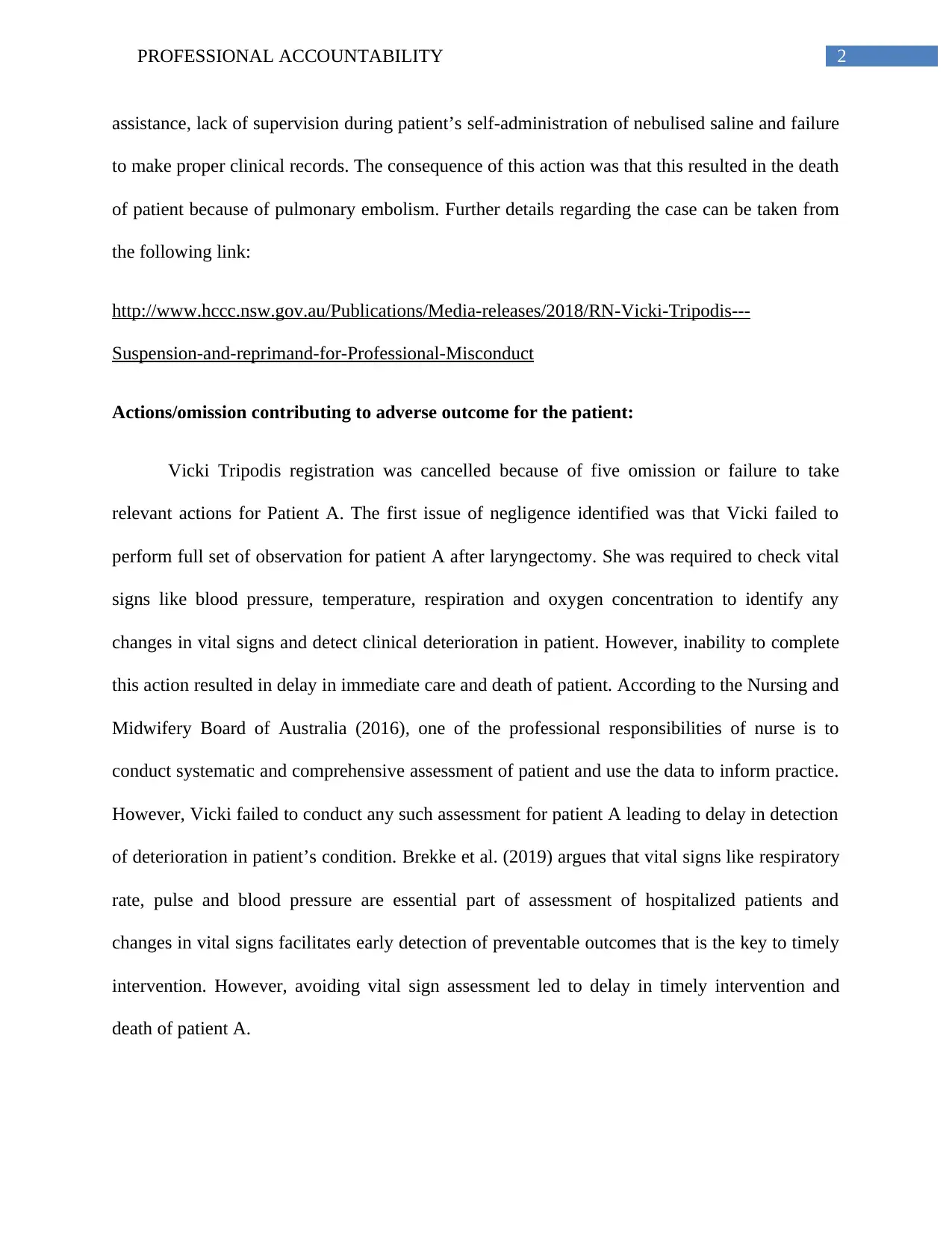
2PROFESSIONAL ACCOUNTABILITY
assistance, lack of supervision during patient’s self-administration of nebulised saline and failure
to make proper clinical records. The consequence of this action was that this resulted in the death
of patient because of pulmonary embolism. Further details regarding the case can be taken from
the following link:
http://www.hccc.nsw.gov.au/Publications/Media-releases/2018/RN-Vicki-Tripodis---
Suspension-and-reprimand-for-Professional-Misconduct
Actions/omission contributing to adverse outcome for the patient:
Vicki Tripodis registration was cancelled because of five omission or failure to take
relevant actions for Patient A. The first issue of negligence identified was that Vicki failed to
perform full set of observation for patient A after laryngectomy. She was required to check vital
signs like blood pressure, temperature, respiration and oxygen concentration to identify any
changes in vital signs and detect clinical deterioration in patient. However, inability to complete
this action resulted in delay in immediate care and death of patient. According to the Nursing and
Midwifery Board of Australia (2016), one of the professional responsibilities of nurse is to
conduct systematic and comprehensive assessment of patient and use the data to inform practice.
However, Vicki failed to conduct any such assessment for patient A leading to delay in detection
of deterioration in patient’s condition. Brekke et al. (2019) argues that vital signs like respiratory
rate, pulse and blood pressure are essential part of assessment of hospitalized patients and
changes in vital signs facilitates early detection of preventable outcomes that is the key to timely
intervention. However, avoiding vital sign assessment led to delay in timely intervention and
death of patient A.
assistance, lack of supervision during patient’s self-administration of nebulised saline and failure
to make proper clinical records. The consequence of this action was that this resulted in the death
of patient because of pulmonary embolism. Further details regarding the case can be taken from
the following link:
http://www.hccc.nsw.gov.au/Publications/Media-releases/2018/RN-Vicki-Tripodis---
Suspension-and-reprimand-for-Professional-Misconduct
Actions/omission contributing to adverse outcome for the patient:
Vicki Tripodis registration was cancelled because of five omission or failure to take
relevant actions for Patient A. The first issue of negligence identified was that Vicki failed to
perform full set of observation for patient A after laryngectomy. She was required to check vital
signs like blood pressure, temperature, respiration and oxygen concentration to identify any
changes in vital signs and detect clinical deterioration in patient. However, inability to complete
this action resulted in delay in immediate care and death of patient. According to the Nursing and
Midwifery Board of Australia (2016), one of the professional responsibilities of nurse is to
conduct systematic and comprehensive assessment of patient and use the data to inform practice.
However, Vicki failed to conduct any such assessment for patient A leading to delay in detection
of deterioration in patient’s condition. Brekke et al. (2019) argues that vital signs like respiratory
rate, pulse and blood pressure are essential part of assessment of hospitalized patients and
changes in vital signs facilitates early detection of preventable outcomes that is the key to timely
intervention. However, avoiding vital sign assessment led to delay in timely intervention and
death of patient A.
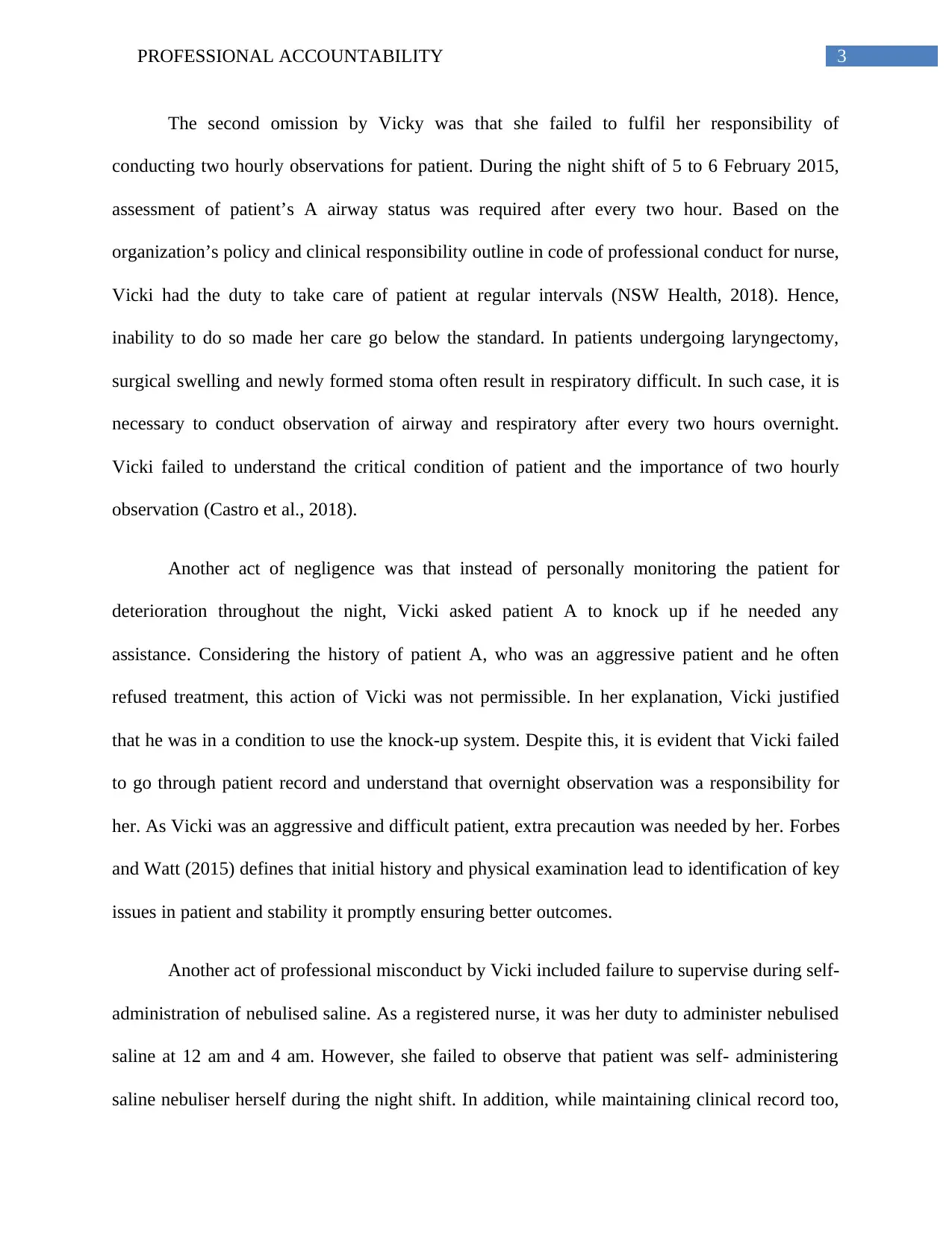
3PROFESSIONAL ACCOUNTABILITY
The second omission by Vicky was that she failed to fulfil her responsibility of
conducting two hourly observations for patient. During the night shift of 5 to 6 February 2015,
assessment of patient’s A airway status was required after every two hour. Based on the
organization’s policy and clinical responsibility outline in code of professional conduct for nurse,
Vicki had the duty to take care of patient at regular intervals (NSW Health, 2018). Hence,
inability to do so made her care go below the standard. In patients undergoing laryngectomy,
surgical swelling and newly formed stoma often result in respiratory difficult. In such case, it is
necessary to conduct observation of airway and respiratory after every two hours overnight.
Vicki failed to understand the critical condition of patient and the importance of two hourly
observation (Castro et al., 2018).
Another act of negligence was that instead of personally monitoring the patient for
deterioration throughout the night, Vicki asked patient A to knock up if he needed any
assistance. Considering the history of patient A, who was an aggressive patient and he often
refused treatment, this action of Vicki was not permissible. In her explanation, Vicki justified
that he was in a condition to use the knock-up system. Despite this, it is evident that Vicki failed
to go through patient record and understand that overnight observation was a responsibility for
her. As Vicki was an aggressive and difficult patient, extra precaution was needed by her. Forbes
and Watt (2015) defines that initial history and physical examination lead to identification of key
issues in patient and stability it promptly ensuring better outcomes.
Another act of professional misconduct by Vicki included failure to supervise during self-
administration of nebulised saline. As a registered nurse, it was her duty to administer nebulised
saline at 12 am and 4 am. However, she failed to observe that patient was self- administering
saline nebuliser herself during the night shift. In addition, while maintaining clinical record too,
The second omission by Vicky was that she failed to fulfil her responsibility of
conducting two hourly observations for patient. During the night shift of 5 to 6 February 2015,
assessment of patient’s A airway status was required after every two hour. Based on the
organization’s policy and clinical responsibility outline in code of professional conduct for nurse,
Vicki had the duty to take care of patient at regular intervals (NSW Health, 2018). Hence,
inability to do so made her care go below the standard. In patients undergoing laryngectomy,
surgical swelling and newly formed stoma often result in respiratory difficult. In such case, it is
necessary to conduct observation of airway and respiratory after every two hours overnight.
Vicki failed to understand the critical condition of patient and the importance of two hourly
observation (Castro et al., 2018).
Another act of negligence was that instead of personally monitoring the patient for
deterioration throughout the night, Vicki asked patient A to knock up if he needed any
assistance. Considering the history of patient A, who was an aggressive patient and he often
refused treatment, this action of Vicki was not permissible. In her explanation, Vicki justified
that he was in a condition to use the knock-up system. Despite this, it is evident that Vicki failed
to go through patient record and understand that overnight observation was a responsibility for
her. As Vicki was an aggressive and difficult patient, extra precaution was needed by her. Forbes
and Watt (2015) defines that initial history and physical examination lead to identification of key
issues in patient and stability it promptly ensuring better outcomes.
Another act of professional misconduct by Vicki included failure to supervise during self-
administration of nebulised saline. As a registered nurse, it was her duty to administer nebulised
saline at 12 am and 4 am. However, she failed to observe that patient was self- administering
saline nebuliser herself during the night shift. In addition, while maintaining clinical record too,
Secure Best Marks with AI Grader
Need help grading? Try our AI Grader for instant feedback on your assignments.
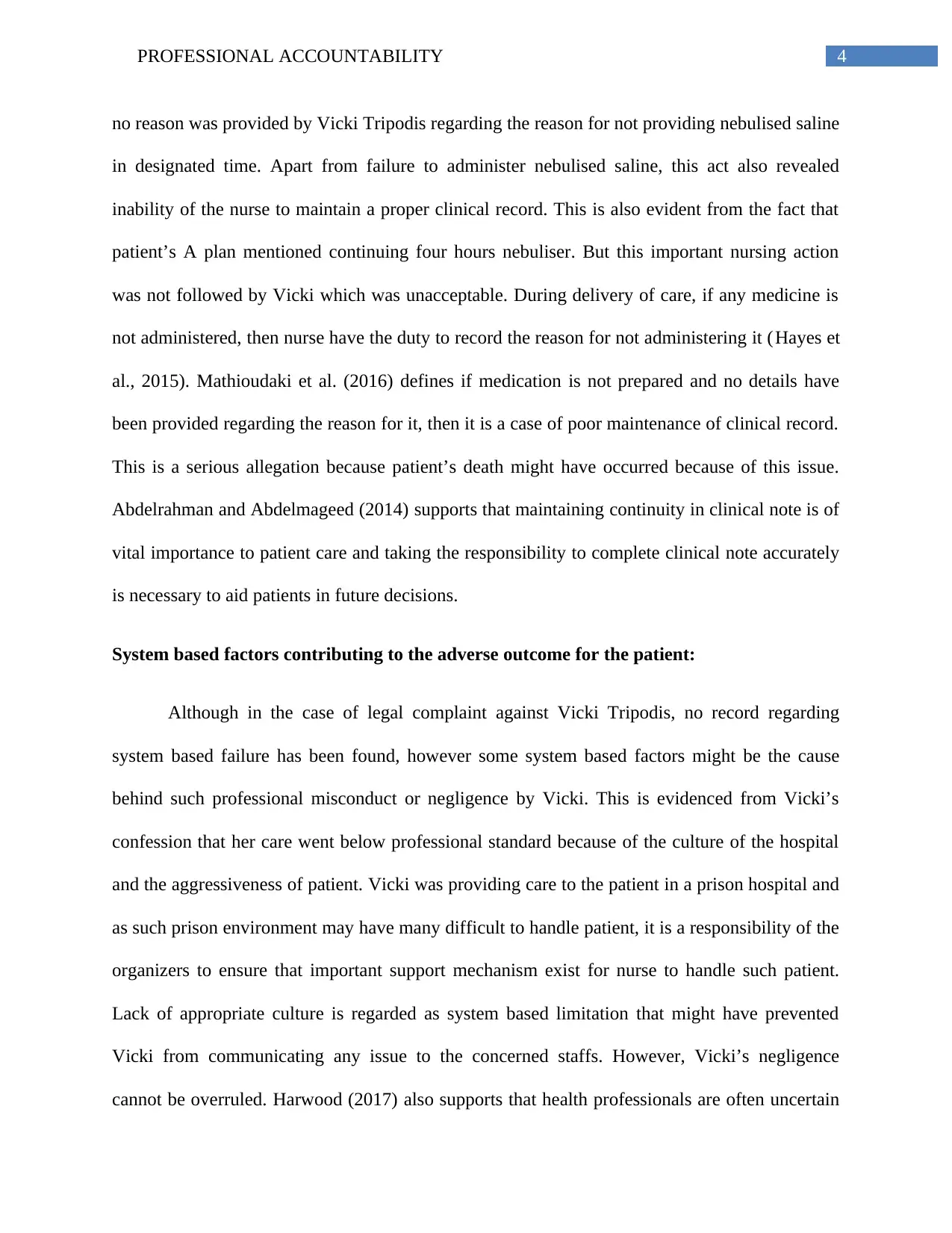
4PROFESSIONAL ACCOUNTABILITY
no reason was provided by Vicki Tripodis regarding the reason for not providing nebulised saline
in designated time. Apart from failure to administer nebulised saline, this act also revealed
inability of the nurse to maintain a proper clinical record. This is also evident from the fact that
patient’s A plan mentioned continuing four hours nebuliser. But this important nursing action
was not followed by Vicki which was unacceptable. During delivery of care, if any medicine is
not administered, then nurse have the duty to record the reason for not administering it (Hayes et
al., 2015). Mathioudaki et al. (2016) defines if medication is not prepared and no details have
been provided regarding the reason for it, then it is a case of poor maintenance of clinical record.
This is a serious allegation because patient’s death might have occurred because of this issue.
Abdelrahman and Abdelmageed (2014) supports that maintaining continuity in clinical note is of
vital importance to patient care and taking the responsibility to complete clinical note accurately
is necessary to aid patients in future decisions.
System based factors contributing to the adverse outcome for the patient:
Although in the case of legal complaint against Vicki Tripodis, no record regarding
system based failure has been found, however some system based factors might be the cause
behind such professional misconduct or negligence by Vicki. This is evidenced from Vicki’s
confession that her care went below professional standard because of the culture of the hospital
and the aggressiveness of patient. Vicki was providing care to the patient in a prison hospital and
as such prison environment may have many difficult to handle patient, it is a responsibility of the
organizers to ensure that important support mechanism exist for nurse to handle such patient.
Lack of appropriate culture is regarded as system based limitation that might have prevented
Vicki from communicating any issue to the concerned staffs. However, Vicki’s negligence
cannot be overruled. Harwood (2017) also supports that health professionals are often uncertain
no reason was provided by Vicki Tripodis regarding the reason for not providing nebulised saline
in designated time. Apart from failure to administer nebulised saline, this act also revealed
inability of the nurse to maintain a proper clinical record. This is also evident from the fact that
patient’s A plan mentioned continuing four hours nebuliser. But this important nursing action
was not followed by Vicki which was unacceptable. During delivery of care, if any medicine is
not administered, then nurse have the duty to record the reason for not administering it (Hayes et
al., 2015). Mathioudaki et al. (2016) defines if medication is not prepared and no details have
been provided regarding the reason for it, then it is a case of poor maintenance of clinical record.
This is a serious allegation because patient’s death might have occurred because of this issue.
Abdelrahman and Abdelmageed (2014) supports that maintaining continuity in clinical note is of
vital importance to patient care and taking the responsibility to complete clinical note accurately
is necessary to aid patients in future decisions.
System based factors contributing to the adverse outcome for the patient:
Although in the case of legal complaint against Vicki Tripodis, no record regarding
system based failure has been found, however some system based factors might be the cause
behind such professional misconduct or negligence by Vicki. This is evidenced from Vicki’s
confession that her care went below professional standard because of the culture of the hospital
and the aggressiveness of patient. Vicki was providing care to the patient in a prison hospital and
as such prison environment may have many difficult to handle patient, it is a responsibility of the
organizers to ensure that important support mechanism exist for nurse to handle such patient.
Lack of appropriate culture is regarded as system based limitation that might have prevented
Vicki from communicating any issue to the concerned staffs. However, Vicki’s negligence
cannot be overruled. Harwood (2017) also supports that health professionals are often uncertain
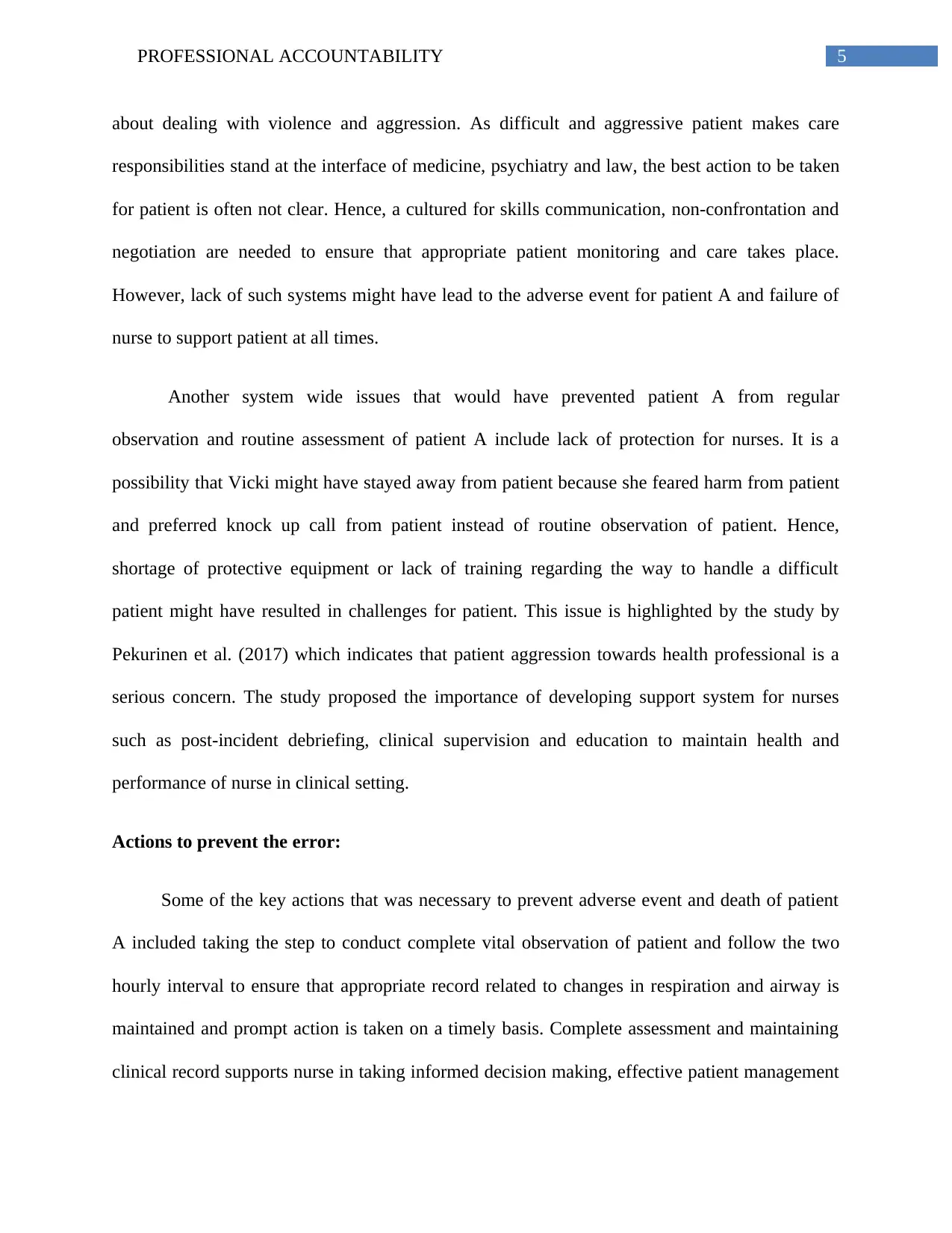
5PROFESSIONAL ACCOUNTABILITY
about dealing with violence and aggression. As difficult and aggressive patient makes care
responsibilities stand at the interface of medicine, psychiatry and law, the best action to be taken
for patient is often not clear. Hence, a cultured for skills communication, non-confrontation and
negotiation are needed to ensure that appropriate patient monitoring and care takes place.
However, lack of such systems might have lead to the adverse event for patient A and failure of
nurse to support patient at all times.
Another system wide issues that would have prevented patient A from regular
observation and routine assessment of patient A include lack of protection for nurses. It is a
possibility that Vicki might have stayed away from patient because she feared harm from patient
and preferred knock up call from patient instead of routine observation of patient. Hence,
shortage of protective equipment or lack of training regarding the way to handle a difficult
patient might have resulted in challenges for patient. This issue is highlighted by the study by
Pekurinen et al. (2017) which indicates that patient aggression towards health professional is a
serious concern. The study proposed the importance of developing support system for nurses
such as post-incident debriefing, clinical supervision and education to maintain health and
performance of nurse in clinical setting.
Actions to prevent the error:
Some of the key actions that was necessary to prevent adverse event and death of patient
A included taking the step to conduct complete vital observation of patient and follow the two
hourly interval to ensure that appropriate record related to changes in respiration and airway is
maintained and prompt action is taken on a timely basis. Complete assessment and maintaining
clinical record supports nurse in taking informed decision making, effective patient management
about dealing with violence and aggression. As difficult and aggressive patient makes care
responsibilities stand at the interface of medicine, psychiatry and law, the best action to be taken
for patient is often not clear. Hence, a cultured for skills communication, non-confrontation and
negotiation are needed to ensure that appropriate patient monitoring and care takes place.
However, lack of such systems might have lead to the adverse event for patient A and failure of
nurse to support patient at all times.
Another system wide issues that would have prevented patient A from regular
observation and routine assessment of patient A include lack of protection for nurses. It is a
possibility that Vicki might have stayed away from patient because she feared harm from patient
and preferred knock up call from patient instead of routine observation of patient. Hence,
shortage of protective equipment or lack of training regarding the way to handle a difficult
patient might have resulted in challenges for patient. This issue is highlighted by the study by
Pekurinen et al. (2017) which indicates that patient aggression towards health professional is a
serious concern. The study proposed the importance of developing support system for nurses
such as post-incident debriefing, clinical supervision and education to maintain health and
performance of nurse in clinical setting.
Actions to prevent the error:
Some of the key actions that was necessary to prevent adverse event and death of patient
A included taking the step to conduct complete vital observation of patient and follow the two
hourly interval to ensure that appropriate record related to changes in respiration and airway is
maintained and prompt action is taken on a timely basis. Complete assessment and maintaining
clinical record supports nurse in taking informed decision making, effective patient management
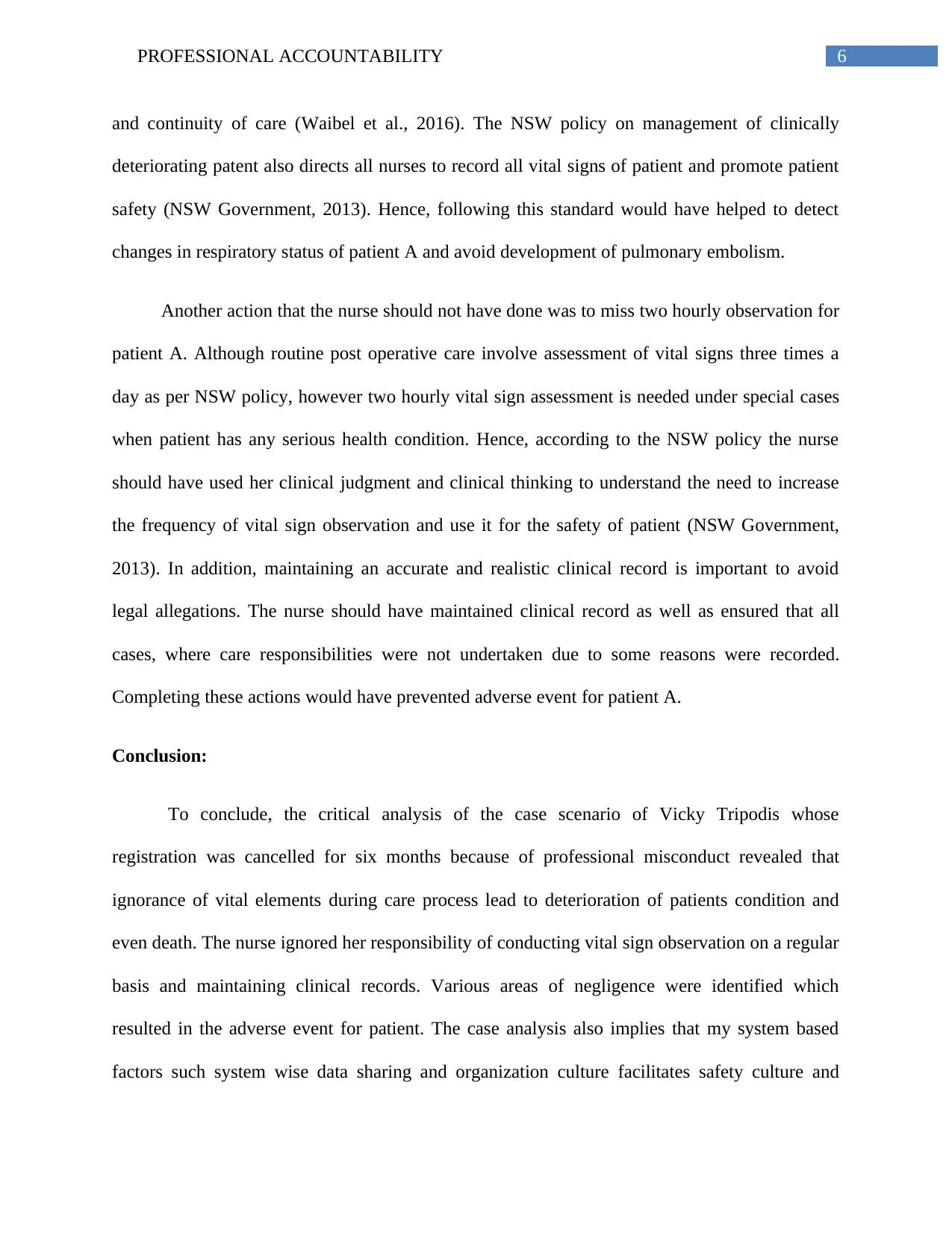
6PROFESSIONAL ACCOUNTABILITY
and continuity of care (Waibel et al., 2016). The NSW policy on management of clinically
deteriorating patent also directs all nurses to record all vital signs of patient and promote patient
safety (NSW Government, 2013). Hence, following this standard would have helped to detect
changes in respiratory status of patient A and avoid development of pulmonary embolism.
Another action that the nurse should not have done was to miss two hourly observation for
patient A. Although routine post operative care involve assessment of vital signs three times a
day as per NSW policy, however two hourly vital sign assessment is needed under special cases
when patient has any serious health condition. Hence, according to the NSW policy the nurse
should have used her clinical judgment and clinical thinking to understand the need to increase
the frequency of vital sign observation and use it for the safety of patient (NSW Government,
2013). In addition, maintaining an accurate and realistic clinical record is important to avoid
legal allegations. The nurse should have maintained clinical record as well as ensured that all
cases, where care responsibilities were not undertaken due to some reasons were recorded.
Completing these actions would have prevented adverse event for patient A.
Conclusion:
To conclude, the critical analysis of the case scenario of Vicky Tripodis whose
registration was cancelled for six months because of professional misconduct revealed that
ignorance of vital elements during care process lead to deterioration of patients condition and
even death. The nurse ignored her responsibility of conducting vital sign observation on a regular
basis and maintaining clinical records. Various areas of negligence were identified which
resulted in the adverse event for patient. The case analysis also implies that my system based
factors such system wise data sharing and organization culture facilitates safety culture and
and continuity of care (Waibel et al., 2016). The NSW policy on management of clinically
deteriorating patent also directs all nurses to record all vital signs of patient and promote patient
safety (NSW Government, 2013). Hence, following this standard would have helped to detect
changes in respiratory status of patient A and avoid development of pulmonary embolism.
Another action that the nurse should not have done was to miss two hourly observation for
patient A. Although routine post operative care involve assessment of vital signs three times a
day as per NSW policy, however two hourly vital sign assessment is needed under special cases
when patient has any serious health condition. Hence, according to the NSW policy the nurse
should have used her clinical judgment and clinical thinking to understand the need to increase
the frequency of vital sign observation and use it for the safety of patient (NSW Government,
2013). In addition, maintaining an accurate and realistic clinical record is important to avoid
legal allegations. The nurse should have maintained clinical record as well as ensured that all
cases, where care responsibilities were not undertaken due to some reasons were recorded.
Completing these actions would have prevented adverse event for patient A.
Conclusion:
To conclude, the critical analysis of the case scenario of Vicky Tripodis whose
registration was cancelled for six months because of professional misconduct revealed that
ignorance of vital elements during care process lead to deterioration of patients condition and
even death. The nurse ignored her responsibility of conducting vital sign observation on a regular
basis and maintaining clinical records. Various areas of negligence were identified which
resulted in the adverse event for patient. The case analysis also implies that my system based
factors such system wise data sharing and organization culture facilitates safety culture and
Paraphrase This Document
Need a fresh take? Get an instant paraphrase of this document with our AI Paraphraser
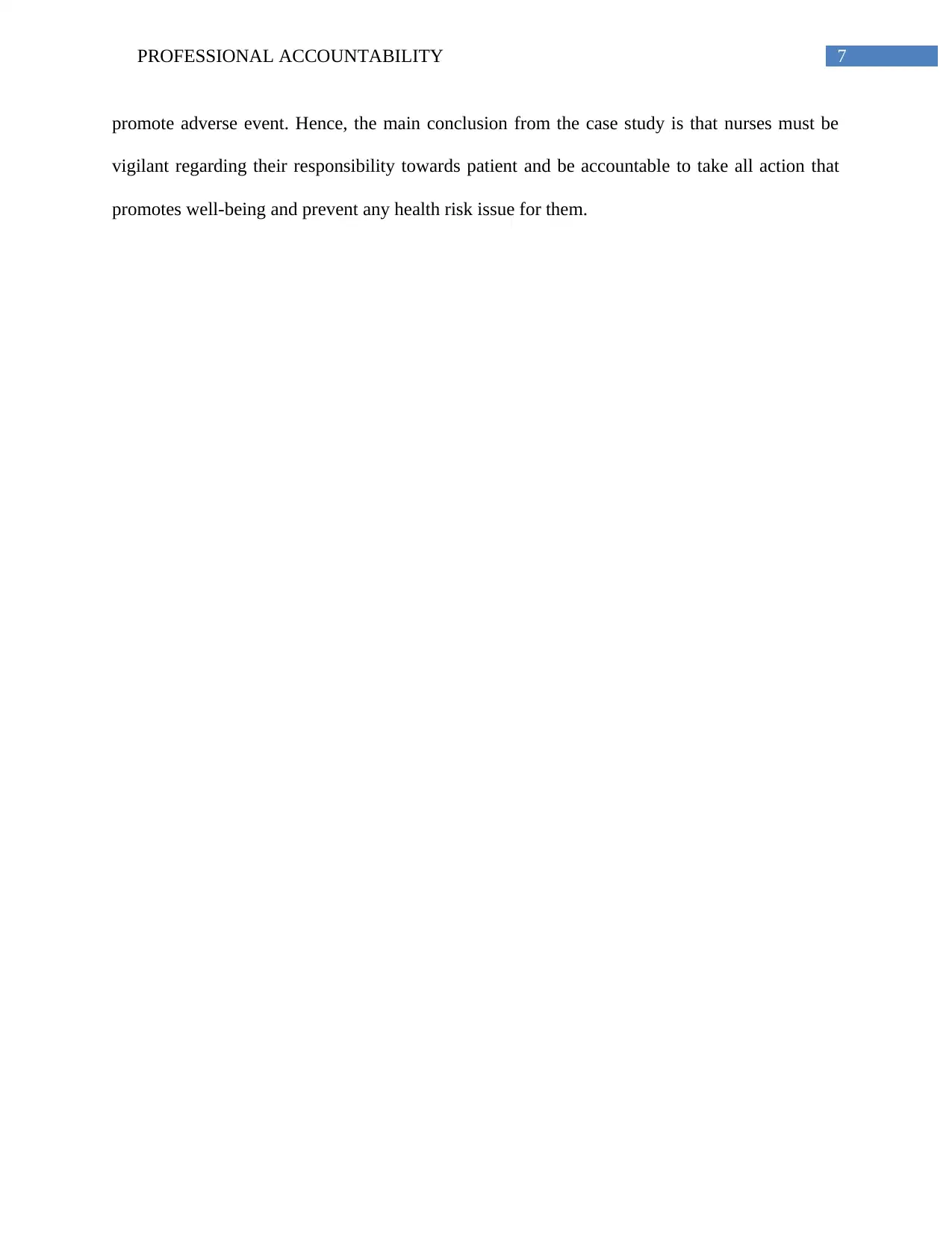
7PROFESSIONAL ACCOUNTABILITY
promote adverse event. Hence, the main conclusion from the case study is that nurses must be
vigilant regarding their responsibility towards patient and be accountable to take all action that
promotes well-being and prevent any health risk issue for them.
promote adverse event. Hence, the main conclusion from the case study is that nurses must be
vigilant regarding their responsibility towards patient and be accountable to take all action that
promotes well-being and prevent any health risk issue for them.
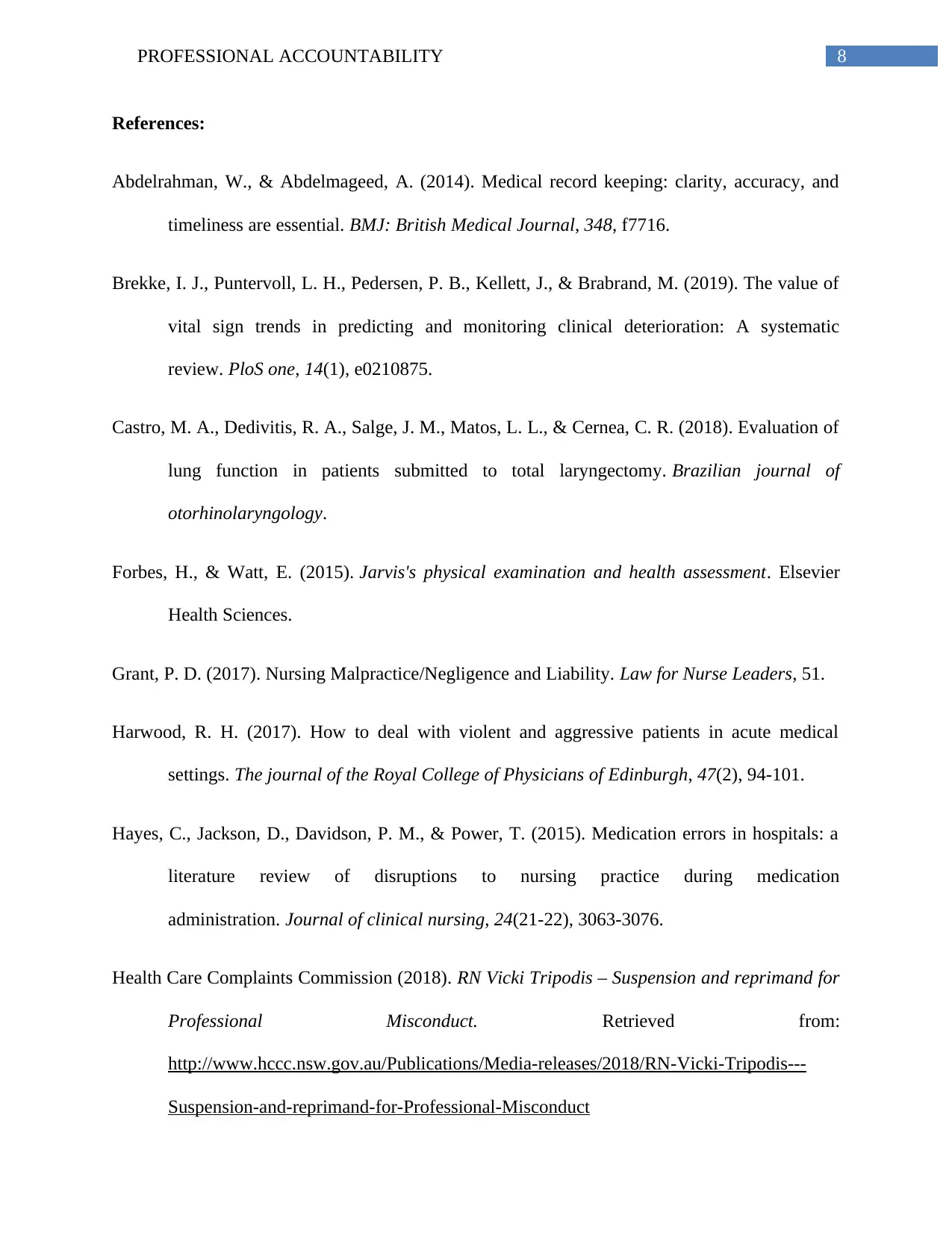
8PROFESSIONAL ACCOUNTABILITY
References:
Abdelrahman, W., & Abdelmageed, A. (2014). Medical record keeping: clarity, accuracy, and
timeliness are essential. BMJ: British Medical Journal, 348, f7716.
Brekke, I. J., Puntervoll, L. H., Pedersen, P. B., Kellett, J., & Brabrand, M. (2019). The value of
vital sign trends in predicting and monitoring clinical deterioration: A systematic
review. PloS one, 14(1), e0210875.
Castro, M. A., Dedivitis, R. A., Salge, J. M., Matos, L. L., & Cernea, C. R. (2018). Evaluation of
lung function in patients submitted to total laryngectomy. Brazilian journal of
otorhinolaryngology.
Forbes, H., & Watt, E. (2015). Jarvis's physical examination and health assessment. Elsevier
Health Sciences.
Grant, P. D. (2017). Nursing Malpractice/Negligence and Liability. Law for Nurse Leaders, 51.
Harwood, R. H. (2017). How to deal with violent and aggressive patients in acute medical
settings. The journal of the Royal College of Physicians of Edinburgh, 47(2), 94-101.
Hayes, C., Jackson, D., Davidson, P. M., & Power, T. (2015). Medication errors in hospitals: a
literature review of disruptions to nursing practice during medication
administration. Journal of clinical nursing, 24(21-22), 3063-3076.
Health Care Complaints Commission (2018). RN Vicki Tripodis – Suspension and reprimand for
Professional Misconduct. Retrieved from:
http://www.hccc.nsw.gov.au/Publications/Media-releases/2018/RN-Vicki-Tripodis---
Suspension-and-reprimand-for-Professional-Misconduct
References:
Abdelrahman, W., & Abdelmageed, A. (2014). Medical record keeping: clarity, accuracy, and
timeliness are essential. BMJ: British Medical Journal, 348, f7716.
Brekke, I. J., Puntervoll, L. H., Pedersen, P. B., Kellett, J., & Brabrand, M. (2019). The value of
vital sign trends in predicting and monitoring clinical deterioration: A systematic
review. PloS one, 14(1), e0210875.
Castro, M. A., Dedivitis, R. A., Salge, J. M., Matos, L. L., & Cernea, C. R. (2018). Evaluation of
lung function in patients submitted to total laryngectomy. Brazilian journal of
otorhinolaryngology.
Forbes, H., & Watt, E. (2015). Jarvis's physical examination and health assessment. Elsevier
Health Sciences.
Grant, P. D. (2017). Nursing Malpractice/Negligence and Liability. Law for Nurse Leaders, 51.
Harwood, R. H. (2017). How to deal with violent and aggressive patients in acute medical
settings. The journal of the Royal College of Physicians of Edinburgh, 47(2), 94-101.
Hayes, C., Jackson, D., Davidson, P. M., & Power, T. (2015). Medication errors in hospitals: a
literature review of disruptions to nursing practice during medication
administration. Journal of clinical nursing, 24(21-22), 3063-3076.
Health Care Complaints Commission (2018). RN Vicki Tripodis – Suspension and reprimand for
Professional Misconduct. Retrieved from:
http://www.hccc.nsw.gov.au/Publications/Media-releases/2018/RN-Vicki-Tripodis---
Suspension-and-reprimand-for-Professional-Misconduct
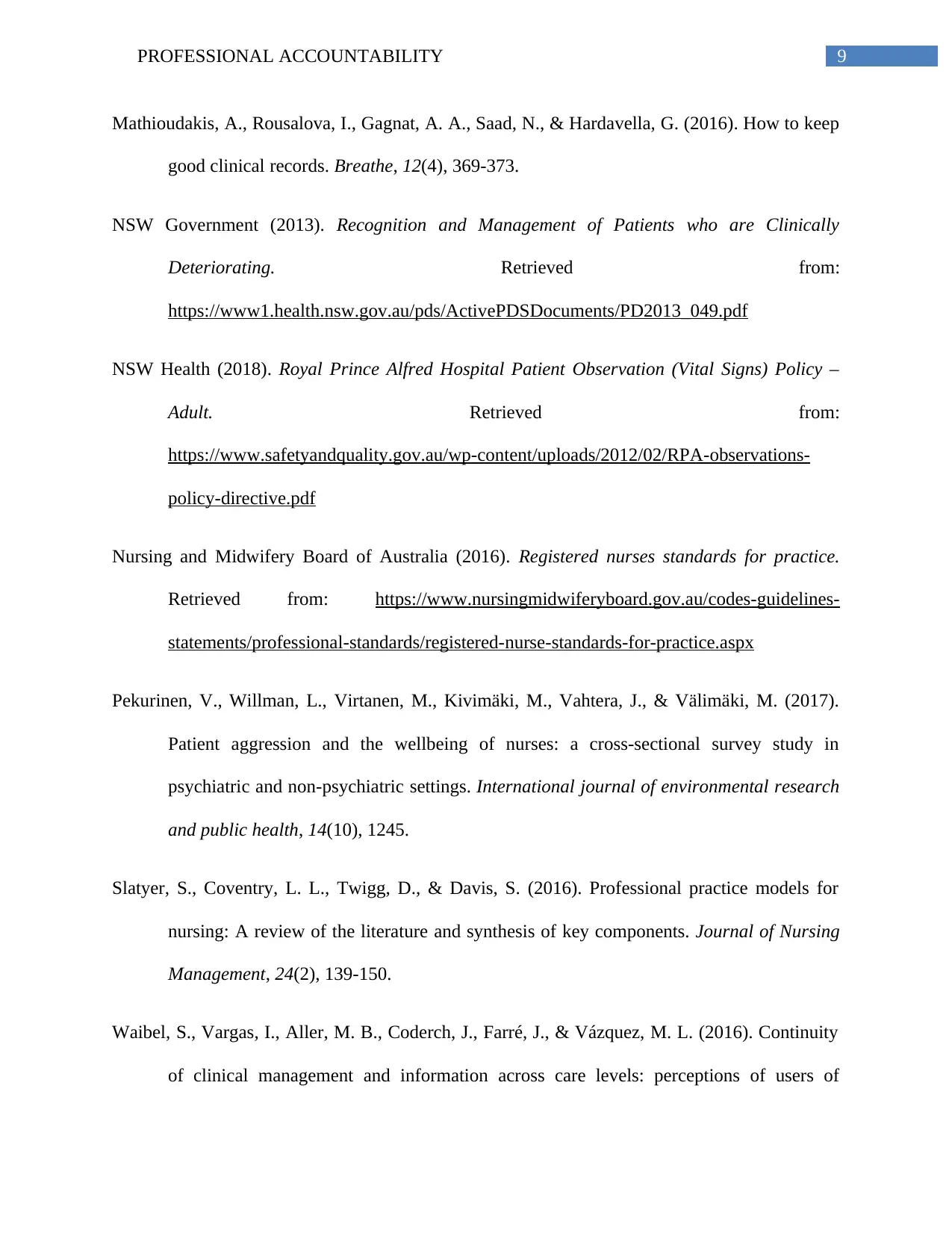
9PROFESSIONAL ACCOUNTABILITY
Mathioudakis, A., Rousalova, I., Gagnat, A. A., Saad, N., & Hardavella, G. (2016). How to keep
good clinical records. Breathe, 12(4), 369-373.
NSW Government (2013). Recognition and Management of Patients who are Clinically
Deteriorating. Retrieved from:
https://www1.health.nsw.gov.au/pds/ActivePDSDocuments/PD2013_049.pdf
NSW Health (2018). Royal Prince Alfred Hospital Patient Observation (Vital Signs) Policy –
Adult. Retrieved from:
https://www.safetyandquality.gov.au/wp-content/uploads/2012/02/RPA-observations-
policy-directive.pdf
Nursing and Midwifery Board of Australia (2016). Registered nurses standards for practice.
Retrieved from: https://www.nursingmidwiferyboard.gov.au/codes-guidelines-
statements/professional-standards/registered-nurse-standards-for-practice.aspx
Pekurinen, V., Willman, L., Virtanen, M., Kivimäki, M., Vahtera, J., & Välimäki, M. (2017).
Patient aggression and the wellbeing of nurses: a cross-sectional survey study in
psychiatric and non-psychiatric settings. International journal of environmental research
and public health, 14(10), 1245.
Slatyer, S., Coventry, L. L., Twigg, D., & Davis, S. (2016). Professional practice models for
nursing: A review of the literature and synthesis of key components. Journal of Nursing
Management, 24(2), 139-150.
Waibel, S., Vargas, I., Aller, M. B., Coderch, J., Farré, J., & Vázquez, M. L. (2016). Continuity
of clinical management and information across care levels: perceptions of users of
Mathioudakis, A., Rousalova, I., Gagnat, A. A., Saad, N., & Hardavella, G. (2016). How to keep
good clinical records. Breathe, 12(4), 369-373.
NSW Government (2013). Recognition and Management of Patients who are Clinically
Deteriorating. Retrieved from:
https://www1.health.nsw.gov.au/pds/ActivePDSDocuments/PD2013_049.pdf
NSW Health (2018). Royal Prince Alfred Hospital Patient Observation (Vital Signs) Policy –
Adult. Retrieved from:
https://www.safetyandquality.gov.au/wp-content/uploads/2012/02/RPA-observations-
policy-directive.pdf
Nursing and Midwifery Board of Australia (2016). Registered nurses standards for practice.
Retrieved from: https://www.nursingmidwiferyboard.gov.au/codes-guidelines-
statements/professional-standards/registered-nurse-standards-for-practice.aspx
Pekurinen, V., Willman, L., Virtanen, M., Kivimäki, M., Vahtera, J., & Välimäki, M. (2017).
Patient aggression and the wellbeing of nurses: a cross-sectional survey study in
psychiatric and non-psychiatric settings. International journal of environmental research
and public health, 14(10), 1245.
Slatyer, S., Coventry, L. L., Twigg, D., & Davis, S. (2016). Professional practice models for
nursing: A review of the literature and synthesis of key components. Journal of Nursing
Management, 24(2), 139-150.
Waibel, S., Vargas, I., Aller, M. B., Coderch, J., Farré, J., & Vázquez, M. L. (2016). Continuity
of clinical management and information across care levels: perceptions of users of
Secure Best Marks with AI Grader
Need help grading? Try our AI Grader for instant feedback on your assignments.
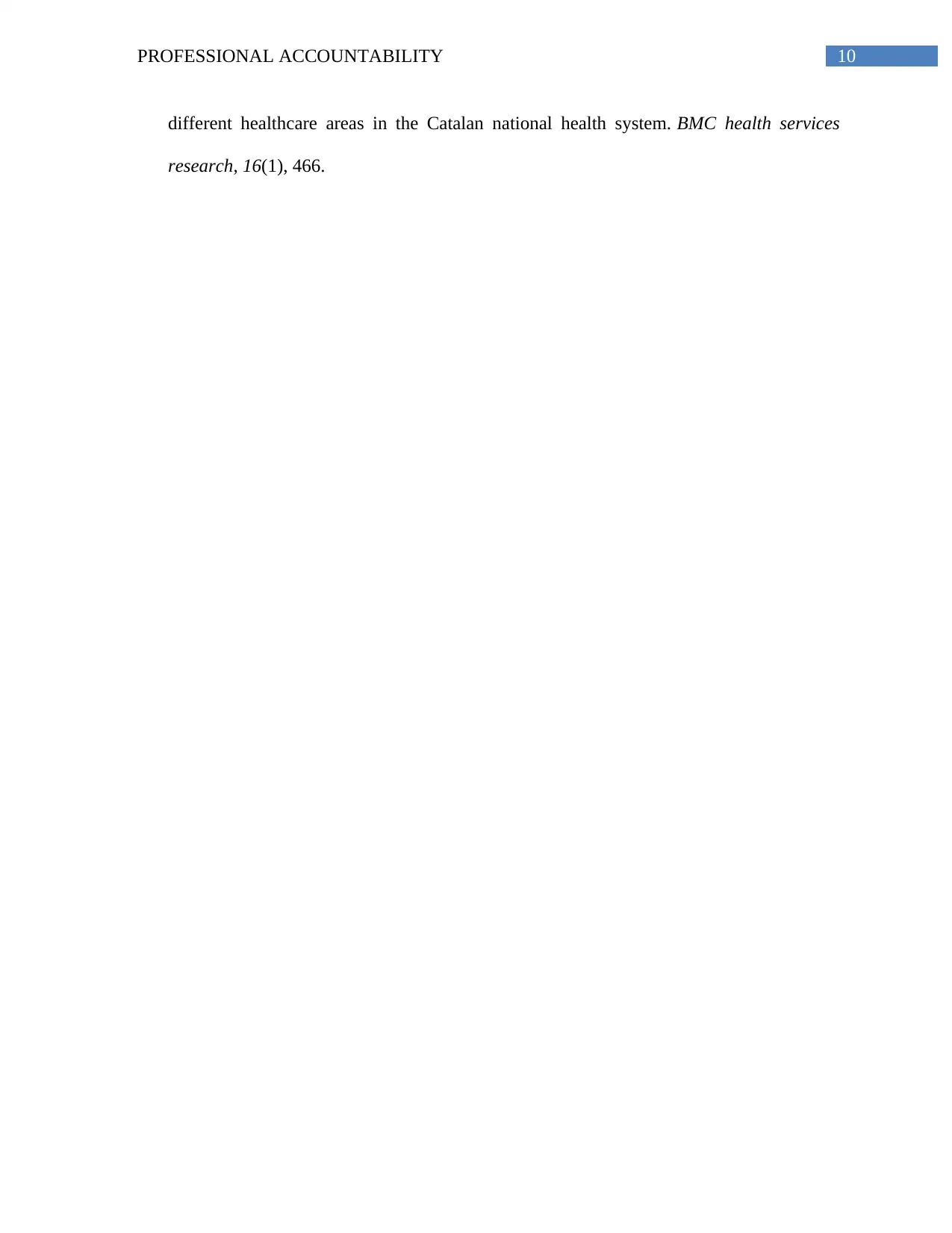
10PROFESSIONAL ACCOUNTABILITY
different healthcare areas in the Catalan national health system. BMC health services
research, 16(1), 466.
different healthcare areas in the Catalan national health system. BMC health services
research, 16(1), 466.
1 out of 11
Related Documents
Your All-in-One AI-Powered Toolkit for Academic Success.
+13062052269
info@desklib.com
Available 24*7 on WhatsApp / Email
![[object Object]](/_next/static/media/star-bottom.7253800d.svg)
Unlock your academic potential
© 2024 | Zucol Services PVT LTD | All rights reserved.





